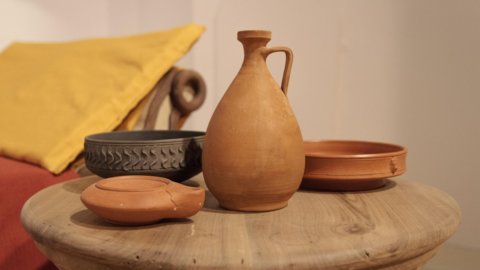On the occasion of the celebrations of the 2200th anniversary of its foundation, Parma hosts at the San Ludovico Gallery, from 2 June to 16 July and from 9 September to 22 October 2017, an exhibition which, through archaeological finds from the Archaeological Museum of Parma and Civic museums of Reggio Emilia, objects, environments, interactive and multimedia installations traces the millenary food culture of Parma, from its origins to the present day.
The exhibition, entitled Archeology and nutrition in the legacy of Roman Parma, curated by Filippo Fontana and Francesco Garbasi with the supervision and scientific advice of Alessia Morigi, is promoted and organized by the Department of Culture of the Municipality of Parma, in collaboration with the University of Parma, the monumental complex of the Pilotta, the VEA archaeological group, and underlines how much the roots of the food culture of the area are in continuity with a distant but extraordinarily close past and more current than ever in the reasons that have made Parma a city Creation of UNESCO Gastronomy, a title reserved for only eighteen cities in the world.
The initiative is part of the "2200 years along the Via Emilia" project, promoted by the Municipalities of Modena, Reggio Emilia and Parma, by the Archeology, Fine Arts and Landscape Superintendencies of Bologna and Parma, by the Regional Secretariat of the Ministry of Cultural Heritage and Activities and Tourism for Emilia-Romagna and by the Emilia-Romagna Region.
Food as the leitmotif of the exhibition reinforces awareness of the roots of quality products, showing their cultural and social value which translates into an economic and qualitative enrichment of the city community.
With Archeology and Nutrition, the vestiges of an ancient past come back to life thanks to contemporary languages. In fact, thanks to the methods provided by experimental archeology and interactive displays, the visitor is accompanied on a path in which, alongside artefacts from excavations carried out in the city, he encounters some holograms that reproduce archaeological objects of considerable interest . To these are added sound environments, tactile and sensory stimuli and an educational video that analyzes the main stages that marked the development of the territory between the XNUMXnd century BC and the XNUMXnd century AD
The exhibition develops topics of great historical interest, such as the organization of crops, obtained through the centuriation system, i.e. the dense network of canals, roads and furrows that formed the great infrastructure that allowed the reclamation, rational subdivision and cultivation of the Po Valley.
The exhibition itinerary explores, in particular, the origins of Parma's food culture - production of ham and cheese - also revealing the typical eating habits of the Roman era, thanks to the archaeological excavations which have clearly defined the basis of the daily diet, there were cereals, together with legumes and fruit, as well as polenta and boiled cereals.
The banquet, understood as a social ritual where people meet, talk and eat together will also be analyzed through the presentation of objects usually used on this occasion, coming from archaeological finds on site and reproductions made by Experimental Archaeologists. Among these are some furnishings made of precious materials such as glass, ceramics and metals, which guaranteed social visibility and prestige in the Roman community.
The exhibition itinerary, enriched by the 3D reconstruction of the Roman urbis form of Parma, curated by the 3D Lab cultural association, also continues outside the Galleria San Ludovico with the Parma Underground itinerary where you can visit the most significant places in the city ancient.
During the opening period of the exhibition, collateral activities will be held which will allow visitors to discover ancient crafts such as that of weaving, organized by the Arcadia Association, or immerse themselves in the atmosphere of the time thanks to historical readings, organized by Francesco Gallina, and guided tours.





